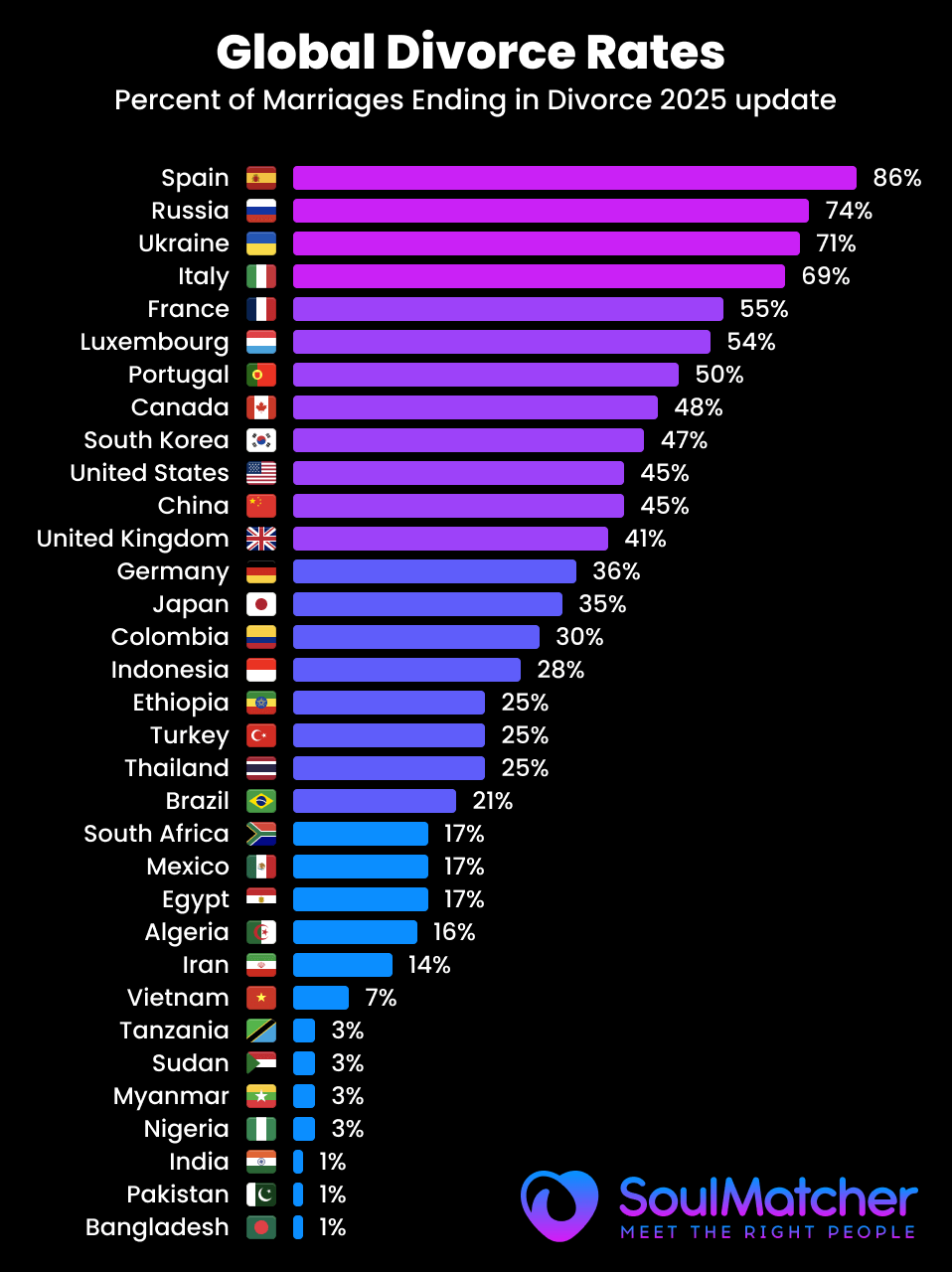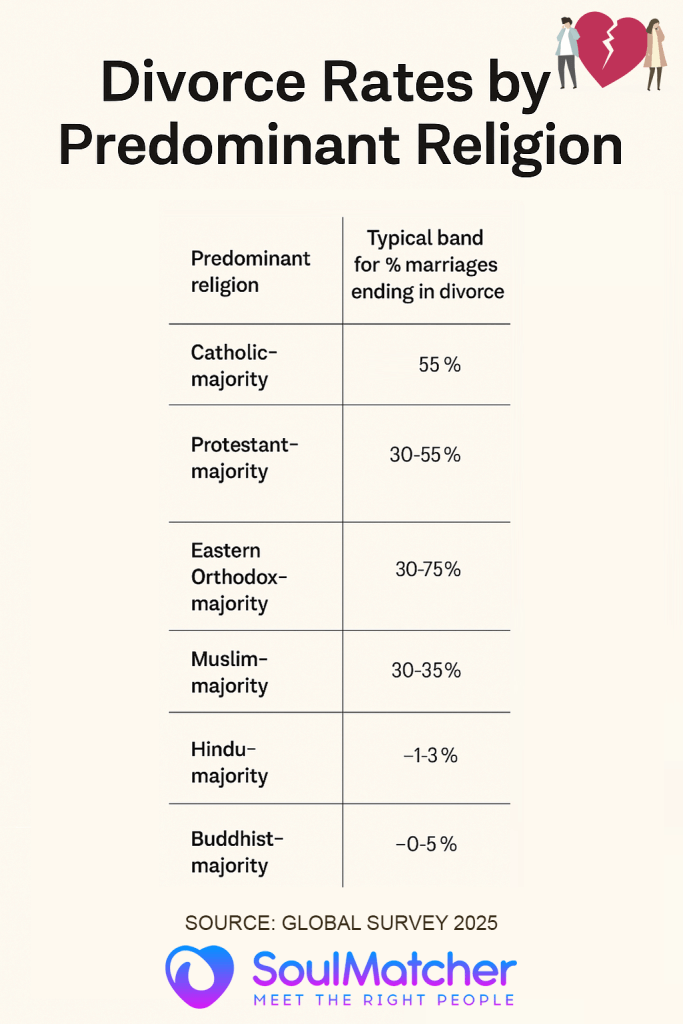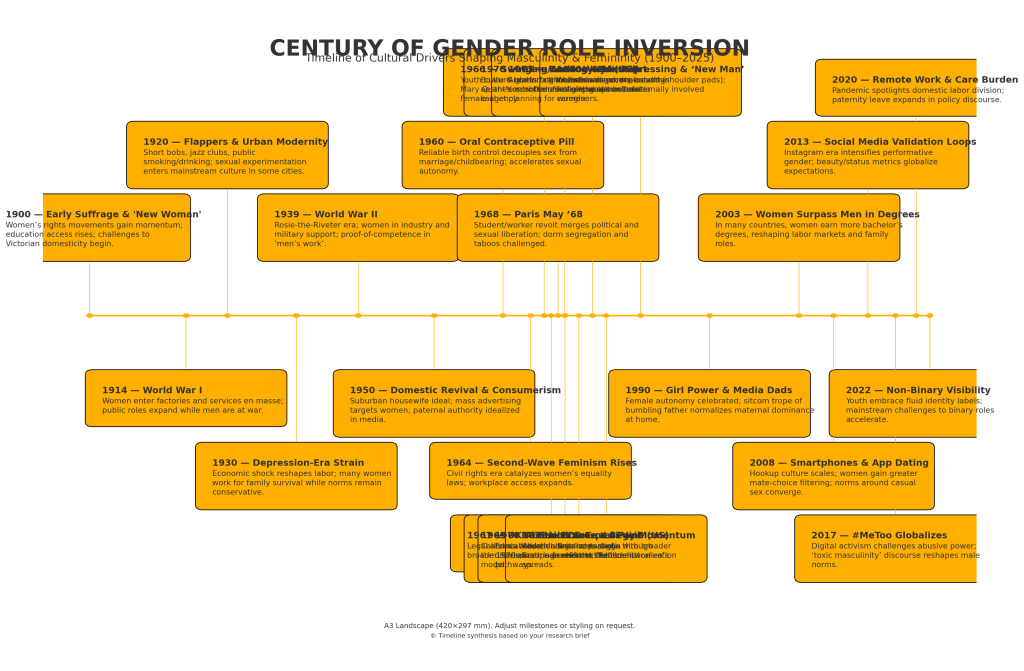Вступ та ключові показники
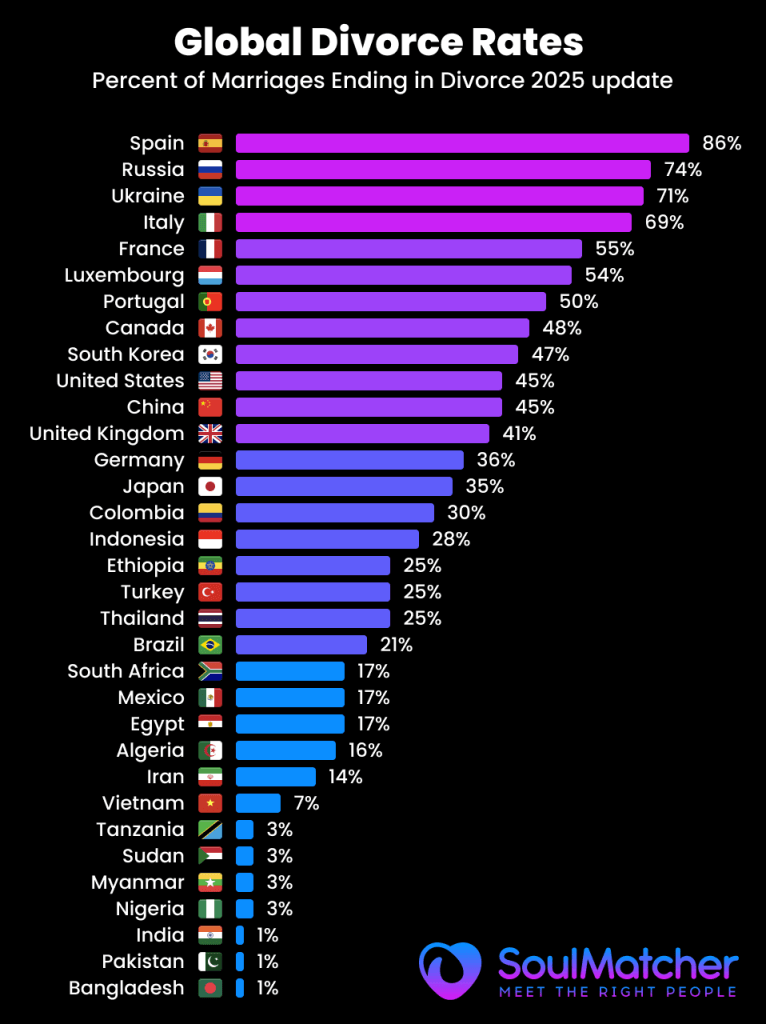
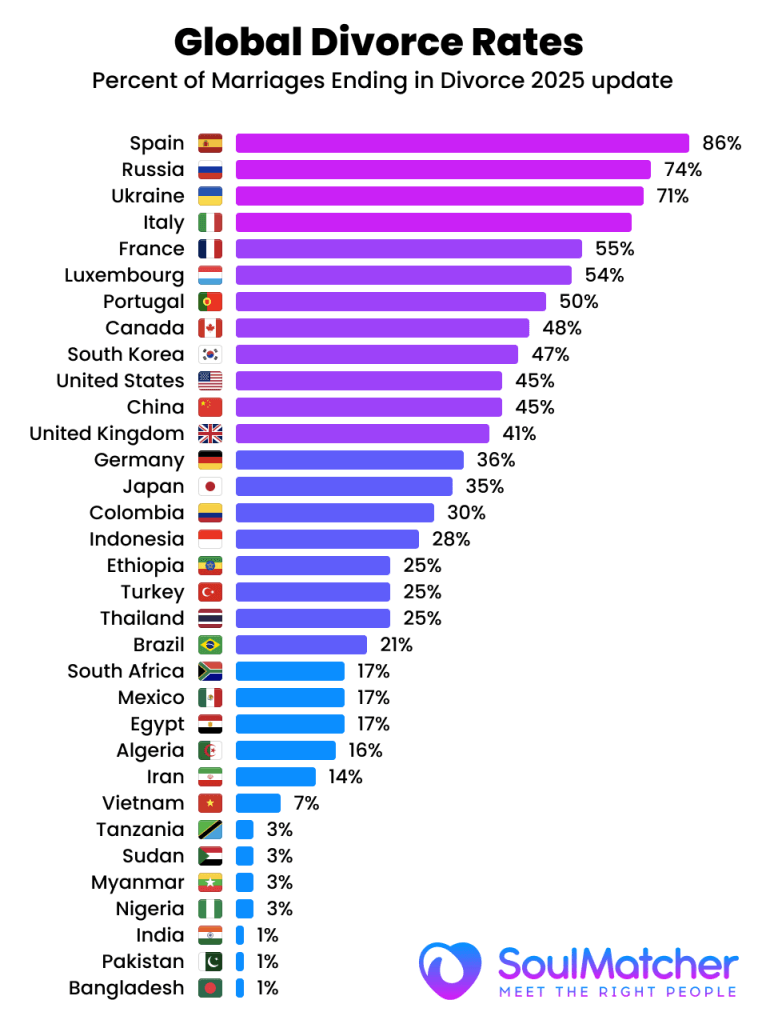
За останні кілька десятиліть розлучення стають все більш поширеним явищем у всьому світі, хоча тенденції сильно відрізняються в різних країнах і регіонах. Загальний рівень розлучень (щорічна кількість розлучень на 1000 осіб) у світі приблизно подвоївся з 1970-х до 2000-х років. Наприклад, в Європейському Союзі рівень розлучень зріс з приблизно 0,8 на 1000 осіб у 1964 році до 2,0 на 1000 у 2023 роцінавіть незважаючи на те, що рівень шлюбності за той самий період знизився на 50%. Однак моделі розлучень далеко не однакові - вони відображають соціальні норми, правову базу та демографічні тенденції кожної країни. Існує два основні способи вимірювання розлучень:
- Загальний рівень розлучень: кількість розлучень на 1000 осіб за певний рік. Це свідчить про щорічну частоту розлучень серед населення.
- Співвідношення розлучень до шлюбів (відсоток розлучень): кількість розлучень по відношенню до кількості шлюбів, часто виражається у відсотках (наприклад, розлучення на 100 шлюбів). Це дає приблизний показник довічний ризик що шлюб врешті-решт закінчиться розлученням. Наприклад, співвідношення 50% свідчить про те, що близько половини шлюбів закінчуються розлученням.
Важливо інтерпретувати ці показники в контексті. На грубі показники може впливати частка населення, яка не перебуває у шлюбі, або вікова структура. Відсоток розлучень є приблизною оцінкою ризику розлучення протягом життя; він припускає, що поточна структура шлюбів і розлучень залишається незмінною, хоча насправді фактичний рівень розлучень протягом життя обчислюється шляхом спостереження за шлюбними когортами протягом певного періоду часу. Тим не менш, ці показники разом дають корисну картину поширеності розлучень.
Статистика розлучень по країнах (останні дані)
У наведених нижче таблицях представлені показники розлучень для країн, щодо яких є достовірні дані, включаючи останній рік даних, загальний коефіцієнт розлучень, загальний коефіцієнт шлюбності та оціночний відсоток шлюбів, які закінчуються розлученням (співвідношення розлучень до шлюбів). Це дає змогу отримати розбивку поширеності розлучень по країнах.
Європа
В Європі спостерігається один з найвищих у світі рівнів розлучень. Багато європейських і колишніх радянських країн пережили сплеск розлучень наприкінці 20-го століття, і зараз 40-90% шлюбів закінчуються розлученням. На противагу цьому, кілька європейських країн, які лише нещодавно легалізували або нормалізували розлучення, демонструють значно нижчі показники.
| Країна | Рік даних | Кількість розлучень на 1000 осіб | Шлюби на 1000 осіб | % шлюбів, що закінчуються розлученням |
|---|---|---|---|---|
| Іспанія | 2020 | 1.6 | 1.9 | 84.2% (світовий рекорд) |
| Росія | 2020 | 3.9 | 5.3 | 73.6% |
| Україна | 2020 | 2.9 | 4.1 | 70.9% |
| Франція | 2016 | 1.9 | 3.7 | 51.3% |
| Португалія | 2023 | 2.0 | 2.8 | 47% |
| Швеція | 2018 | 2.5 | 5.0 | 50.0% |
| Італія | 2018 | 1.5 | 3.2 | 46.9% |
| Німеччина | 2017 | 1.9 | 4.9 | 38.8% |
| Сполучене Королівство (E&W) | 2015 | 1.8 | 4.4 | 40.9% |
| Польща | 2018 | 1.7 | 5.1 | 33.3% |
| Румунія | 2018 | 1.6 | 7.4 | 21.6% |
| Ірландія | 2017 | 0.7 | 4.6 | 15.2% |
| Мальта | 2018 | 0.7 | 5.8 | 12.1% |
Європа: Іспанія виділяється з оцінкою 90% шлюбів, що закінчуються розлученнямодин з найвищих у світі. На противагу цьому, традиційно католицькі країни, які лише нещодавно дозволили розлучення (наприклад Мальта (2011), Ірландія (1996)) все ще мають дуже низький рівень розлучень (менше 0,8 на 1000) і лише близько 12-15% шлюбів закінчуються розлученням. Основні західноєвропейські країни знаходяться в проміжку між цими показниками: наприклад, близько 50% шлюбів у Франція закінчуються розлученням, ~41% в ВЕЛИКОБРИТАНІЯі ~.39% в Німеччина. Скандинавські країни мають близько 45-50% шлюбів, що закінчуються розлученням (наприклад, Швеція ~50%). Багато країн Східної Європи та пострадянського простору мають високий рівень розлучень: наприклад, Росія (74%) та Україна (71%). У цих країнах спостерігався сплеск розлучень під час і після радянської епохи. У той же час, кілька східноєвропейських країн підтримують нижчі показники (Румунія ~ 22%, що традиційно пов'язано з більш консервативними нормами). Загалом, загальний рівень розлучень в Європі коливається в межах Від 1 до 3 на 1000з медіаною близько 1,5-2,5 на 1000, але відсоткове співвідношення розлучень до кількості шлюбів сильно варіюється через різний рівень шлюбності. Частково довгострокове зростання кількості розлучень у Європі було зумовлене законодавчими змінами - розлучення було легалізовано в Італії (1970), Іспанії (1981), Ірландії (1996) та Мальті (2011), що сприяло зростанню кількості розлучень у цих країнах з плином часу.
Північна Америка
У Північній Америці також відносно високий рівень розлучень, хоча останнім часом у деяких регіонах спостерігається тенденція до його зниження.
| Країна | Рік даних | Кількість розлучень на 1000 осіб | Шлюби на 1000 | % шлюбів, що закінчуються розлученням |
|---|---|---|---|---|
| Сполучені Штати | 2020 | 2.3 | 5.1 | 45.1% |
| Канада | 2008 | 2.1 | 4.4 | 47.7% |
| Куба | 2010 | 2.9 | 5.2 | 55.8% |
| Мексика | 2020 | ~1.0 | ~5.5 (приблизно) | ~20% (ест.) |
| Чилі | 2009 | 0.7 | 3.3 | 21.2% |
| Гватемала | 2019 | (дуже низький) | (високий) | ~5% (ест.) |
Північна Америка: У "The Сполучені Штати вже давно має один з найвищих загальних коефіцієнтів розлучень серед великих країн (піковий показник близько 5,0 на початку 1980-х років). У 2000 році цей показник у США становив 4,0 на 1000, але відтоді він знизився до 2,3 на 1 000 станом на 2020 рік. Сьогодні близько 42-45% шлюбів у США закінчуються розлученням. Сусідні Канада схожа з приблизно 48% шлюбів закінчуються розлученням (станом на 2008 рік). У країнах Карибського басейну та Центральної Америки, Куба має надзвичайно високий рівень розлучень - близько 56% шлюбів закінчуються розлученням, що відображає історичну легкість розлучення в цих країнах. На противагу цьому, МексикаЗагальний коефіцієнт розлучень (~1,0) є досить низьким; через сильні сімейні традиції лише приблизно 20-25% мексиканських шлюбів закінчуються розлученням (приблизні дані на основі останніх даних). У деяких латиноамериканських країнах історично був дуже низький рівень розлучень (у деяких випадках через те, що донедавна розлучення були заборонені або були рідкісним явищем). Наприклад, Чилі легалізувала розлучення лише у 2004 році, і до 2009 року рівень розлучень все ще залишався низьким (0,7 на 1000, ~21% шлюбів). Загалом, у 21 столітті кількість розлучень у Латинській Америці зростає, але культурні норми утримують цей показник на помірному рівні - багато країн Центральної Америки (наприклад, Гватемала, Гондурас) повідомляють про менш ніж 1 розлучення на 1000 осіб, що означає, що менш ніж 10% шлюбів закінчуються легальним розлученням (хоча неформальні розлучення можуть бути вищими).
Азія
Азія демонструє найширший асортимент Рівень розлучень у різних країнах відрізняється, що відображає відмінності в культурі та законодавстві. У деяких країнах Східної Азії та Євразії спостерігається найвищий рівень розлучень, тоді як у Південній Азії - найнижчий.
| Країна | Рік даних | Кількість розлучень на 1000 осіб | Шлюби на 1000 | % шлюбів, що закінчуються розлученням |
|---|---|---|---|---|
| Китай | 2018 | 3.2 | 7.2 | 44.4% |
| Південна Корея | 2019 | 2.2 | 4.7 | 46.8% |
| Японія | 2019 | 1.7 | 4.8 | 35.4% |
| Ізраїль | 2009 | 1.8 | 6.5 | 27.7% |
| Саудівська Аравія | 2020 | 2.1 | 5.6 | 37.5% |
| Казахстан | 2021 | 2.5 | 7.3 | 34.3% |
| Туреччина | 2018 | 1.7 | 6.8 | 25.0% |
| В'єтнам | 2015 | 0.4 | 5.7 | 7.0% |
| Індія | ~2018 | 0.1 | ~10 | ~1% (найнижчий) |
| Філіппіни | Н/Д | розлучення нелегальне | - | 0% (законодавча заборона) |
Азія: Кілька Східна Азія країни зазнали швидких соціальних змін і тепер мають високий рівень розлучень. Південна КореяРівень розлучень різко зріс у 1990-2000-х роках і до 2019 року становив близько 47% шлюбів закінчувалися розлученням. КитайРівень розлучень аналогічно зріс у 2000-х роках приблизно до 3,2 на 1 000 (44% шлюбів) до 2018 року, що відображає урбанізацію та спрощення процедури розлучення - фактично, кількість китайських розлучень зростала щороку протягом 16 років, аж до 2019 року. (Новий закон про "охолодження" у 2021 році спричинив раптове падіння кількості розлучень у Китаї, але дискутується, чи буде це довготривалим, чи просто відтермінує розлучення). Японія досягла пікового рівня розлучень близько 2002 року, а потім знизилася; станом на 2019 рік цей показник в Японії становить 1,7 на 1000, причому приблизно 35% шлюбів закінчуються розлученням. У Південно-Східна Азіярівень розлучень, як правило, помірний або низький, частково через релігійні та культурні норми. Наприклад, В'єтнам тільки звіти 0,4 розлучення на 1000 і ~7% шлюбів закінчуються розлученням. Індонезія також має низький загальний коефіцієнт розлучень (~1,2), незважаючи на велику кількість мусульманського населення (іслам дозволяє розлучення, але на практиці вони залишаються нечастими). Південна Азія має найнижчий рівень розлучень у світі - Індії загальний рівень розлучень становить лише близько 0,1 на 1 000і лише близько 1% індійських шлюбів закінчуються законним розлученням. Цей надзвичайно низький показник пояснюється сильною соціальною стигматизацією розлучень, тиском розширеної сім'ї та юридичними перешкодами в Індії. Інші країни Південної Азії та Близького Сходу також повідомляють про дуже низький відсоток розлучень (наприклад Шрі-Ланка ~0,15 на 1000, кілька відсотків шлюбів). З іншого боку, в деяких частинах Близького Сходу вище рівень розлучень: наприклад, Саудівська Аравія і Казахстан (країна Центральної Азії з мусульманською більшістю населення) обидва див. 30-40% шлюбів закінчуються розлученням. У країнах Перської затоки розлучення є відносно поширеним явищем, наприклад Кувейт становив близько 421ТП3Т у 2010 році - цьому сприяло дозвільне законодавство для чоловіків, хоча жінки стикаються з більшими перешкодами. Зокрема, Філіппіни (і Ватикан) виділяються як єдині країни де розлучення повністю незаконнещо призводить до того, що, по суті 0% шлюбів, які законно закінчуються розлученням (розірвання шлюбу можливе, але рідкісне явище). Такі законодавчі заборони утримують зареєстрований рівень розлучень на нульовому рівні, навіть якщо розлучення все ще відбуваються.
Африка
Достовірної статистики розлучень в Африці небагато, але наявні дані свідчать про загалом низький рівень розлучень, за деякими винятками. Багато африканських шлюбів укладаються за звичаями або за релігійними переконаннями і можуть розриватися поза межами офіційної правової системи, що робить офіційну кількість розлучень низькою.
| Країна | Рік даних | Кількість розлучень на 1000 осіб | Шлюби на 1000 | % шлюбів, що закінчуються розлученням |
|---|---|---|---|---|
| Південна Африка | 2009 | 0.6 | 3.5 | 17.1% |
| Єгипет | 2021 | 2.4 | (приблизно ~9) | ~25% (ест.) |
| Маврикій | 2010 | 1.4 | 8.2 | 17.1% |
| Нігерія | ~2016 | (дуже низький) | (високий) | (<5%) (ест.) |
| Марокко/Алжир | ~2018 | ~1-1.5 | ~7-8 | ~15-20% (ест.) |
Африка: У багатьох африканських країнах загальний коефіцієнт розлучень нижче 1 на 1000що свідчить про відносно невелику кількість офіційних розлучень. Наприклад, Південна Африка - один з найкраще задокументованих випадків - мав лише 0,6 розлучень на 1000 у 2009 році, що відповідає приблизно 17% шлюбів, що закінчуються розлученням. Низький рівень розлучень пояснюється кількома факторами: сильним соціальним/релігійним несхваленням розлучень у деяких частинах Африки, поширеністю неформального розлучення або полігамних союзів, які можуть не закінчуватися в суді, а також практичними труднощами (особливо для жінок) в отриманні розлучень. У Північній Африці та на Близькому Сході, де на шлюб впливає ісламське право, розлучення дозволене законом, але часто супроводжується певними умовами. Єгипетнаприклад, в останні роки спостерігається зростання кількості розлучень (2,4 на 1000 осіб у 2021 році) - один з найвищих показників в Африці - через те, що повільно змінюється ставлення до розлучень, хоча жінкам часто доводиться відмовлятися від фінансових прав для того, щоб ініціювати розлучення. Інші африканські країни, такі як Маврикій (17%) та Марокко (~15-20%) мають помірне співвідношення кількості розлучень до кількості шлюбів. Загалом, африканські суспільства цінують стабільність шлюбу, і багато розлучень відбувається поза офіційною статистикою (наприклад, через старійшин громади). Варто зазначити, що в деяких частинах Африки на південь від Сахари, нестабільність профспілок може бути високою (через такі фактори, як соціально-економічний стрес або вдівство), але вони не завжди реєструються як "розлучення" в даних. Там, де дані існують, вони часто демонструють закономірність: міське та освічене населення має вищий рівень розлучень, ніж сільське, що відображає більшу автономію подружніх пар у питанні розлучення.
Океанія
Структура розлучень в Океанії подібна до західних країн.
| Країна | Рік даних | Кількість розлучень на 1000 осіб | Шлюби на 1000 | % шлюбів, що закінчуються розлученням |
|---|---|---|---|---|
| Австралія | 2020 | 1.9 (розрахунковий) | 4.6 (ест.) | ~41% |
| Нова Зеландія | 2020 | 1,5 (розрахунковий) | 3.6 (розрахунковий) | ~42% |
| Фіджі / Тихоокеанські острови | ~2018 | (низький) | (варіюється) | (10-20%) (ест.) |
Океанія: Австралія і Нова Зеландія мають рівень розлучень, порівнянний з Європою та Північною Америкою. Приблизно 40-45% шлюбів в Австралії та Новій Зеландії, як очікується, закінчаться розлученням. Наприклад, у Новій Зеландії загальний коефіцієнт розлучень становив 1,6 на 1000 у 2022 році, а на 1000 існуючих подружніх пар того року припадало близько 7,6 розлучень, що означає аналогічний ризик розлучень близько 40%. В обох країнах спостерігалося зростання кількості розлучень наприкінці 20-го століття, але в останні роки показники стабілізувалися або дещо знизилися, оскільки рівень шлюбності знизився. На противагу цьому, багато менших тихоокеанських острівних держав (Фіджі, Самоа та ін.) мають більш консервативні сімейні структури і обмежені дані, але окремі свідчення вказують на відносно низький рівень розлучень (часто менше 1 на 1000).
Примітки до таблиці: Дані відображають останній наявний рік (у дужках). "% шлюбів, що закінчуються розлученням" розраховується як розлучення ÷ шлюби × 100 для цього року (оцінка високого рівня ризику розлучення протягом життя). Фактична ймовірність розлучення протягом життя може дещо відрізнятися, особливо в країнах, що переживають швидкі зміни. Тим не менш, цей відсоток є корисним порівняльним показником. Ми посилаємося на авторитетні джерела, включаючи Демографічний щорічник Організації Об'єднаних Націй та національні статистичні агентства. Загалом, глобальний рівень розлучень коливається від менш ніж 0,5 на 1000 (у кількох суспільствах з низьким рівнем розлучень) до приблизно 3-4 на 1000 у країнах з найвищим рівнем розлученьтоді як частка шлюбів, що закінчуються розлученням, коливається від менш ніж 5% до більш ніж 90% - дивовижний діапазон, що відображає правові та культурні крайнощі.
Найвищий та найнижчий рівень розлучень у світі
На глобальному рівні найвищий загальний рівень розлучень (на 1000 осіб) спостерігаються в різних країнах пострадянського простору, в деяких частинах Європи та в деяких інших регіонах. Згідно з останніми даними ООН, до числа країн з найвищими річними показниками розлучень належать
- Північна Македонія: 9,6 розлучень на 1000 осіб (2023) - нещодавній сплеск виводить цю маленьку балканську країну на перше місце (цей незвично високий показник у 2023 році може бути пов'язаний з великою кількістю розлучень, розглянутих після пандемії, або з іншими аномаліями).
- Мальдіви: 5,5 на 1 000 (2020) - історично Мальдіви мали надзвичайно високий рівень розлучень (піковий показник 10,97 на 1000 осіб у 2002 році, що є світовим рекордом Гіннеса), що пояснюється культурними нормами багатошлюбності. Навіть в останні роки Мальдіви лідирують у світі з показником 5+ розлучень на 1000 осіб.
- Білорусь, Грузія, Молдова: навколо 3,7-3,8 на 1000 (2021-2022). Кілька колишніх республік СРСР очолюють список, що відображає високий рівень сприйняття розлучень у суспільстві та економічний стрес у пострадянську епоху. Наприклад, у Білорусі цей показник становить 3,7, а в Молдові - 3,7 на 1000.
- Латвія, Литва: ~2,5-2,9 на 1000 (2022). У країнах Балтії спостерігається стабільно високий рівень розлучень, причому в Латвії цей показник наразі найвищий в ЄС - 2,8.
- Сполучені Штати: ~2,3 на 1000 (2020) - якщо раніше США були серед лідерів, то зараз їхній показник знизився і є помірним порівняно зі Східною Європою.
З точки зору "довічний" ризик розлучення (частка шлюбів, що закінчуються розлученням)лідери дещо відрізняються, що підкреслює вплив низького рівня шлюбності в деяких країнах. Серед них - країни з найвищим відсотком розлучень:
- Іспанія: ~85% шлюбів закінчуються розлученням. Після легалізації розлучень у 1981 році рівень розлучень в Іспанії стрімко зріс, і при відносно невеликій кількості нових шлюбів коефіцієнт розлучень за останніми даними є надзвичайно високим.
- Росія: 73-74%; Україна: ~71%; Білорусь: ~60-65% (ест.). Ці слов'янські країни мають високий шлюбний оборот - багато шлюбів, але ще більше розлучень відносно цієї кількості.
- Куба: ~56%; Франція: ~51%; Швеція: 50%. Багато західних країн групуються навколо позначки 50%, що означає, що приблизно половина шлюбів зрештою розпадається (часто цитована фраза "половина всіх шлюбів закінчується розлученням" приблизно відповідає дійсності для США, Франції, Великої Британії і т.д.).
На противагу цьому, в найнижчий рівень розлучень зустрічаються в суспільствах, де існують юридичні або культурні бар'єри для розлучення. До них відносяться:
- Індія: Тільки про 1% шлюбів закінчуються розлученням. Загальний коефіцієнт розлучень в Індії (~0,1) є одним з найнижчих у світі. Сильна стигма і очікування витримати шлюб призводять до дуже малої кількості розлучень.
- Бутан, Шрі-Ланка, В'єтнам: Тільки 5-7% шлюбів закінчуються розлученням. У цих азійських країнах цей показник значно нижчий за 0,5 на 1000. У Шрі-Ланці, наприклад, цей показник становить 0,15, а розлучення часто вимагає тривалого судового процесу.
- Колумбія та багато африканських країн: Часто 10-20% ймовірність розлучення. У багатьох африканських і латиноамериканських країнах із сильним впливом католицької церкви або громади (наприклад, Гватемала, Конго, Нігерія) кількість розлучень дуже низька.
- Філіппіни та Ватикан: 0% (законне розлучення неможливе). На Філіппінах шлюб може бути розірваний лише через анулювання або смерть. Не дивно, що офіційний рівень розлучень фактично дорівнює нулю, і країна часто опиняється внизу світових рейтингів розлучень.
Малюнок: Світова карта поширеності розлучень ("ймовірність розлучення" за країнами). Тепліші кольори (червоний) вказують на вищі показники або ймовірність розлучень, тоді як холодніші кольори (зелений) вказують на нижчі показники розлучень. Сірий колір означає недостатню кількість даних. Ця карта підкреслює, що розлучення найбільш поширені в колишньому СРСР, деяких країнах Європи та Північної Америки, тоді як вони найменш поширені в Південній Азії, деяких країнах Африки та Південно-Східної Азії.
Як видно з карти та даних, рівень розлучень різко відрізняється в різних регіонах. Загалом, розвинені регіони та регіони з більш ліберальними соціальними нормами (Європа, Північна Америка, Океанія) мають вищі показники розлучень, тоді як регіони, що розвиваються, з більш традиційними або обмежувальними нормами (Південна Азія, Близький Схід, Африка), мають нижчі показники. Однак є й помітні винятки - наприклад, багатші країни Східної Азії (Японія, Корея) мають помірні показники, а деякі бідніші країни (наприклад, на пострадянському просторі) мають високі показники через унікальні історичні фактори. Культурні погляди, релігія та правові структури значною мірою впливають на ці результати, про що йтиметься далі.
Історичні тенденції розлучень в основних країнах
Рівень розлучень у багатьох країнах слідував за перевернута U-подібна форма за останні 50 з гаком років: різке зростання у 1970-1990-х роках, потім плато або зниження у 2000-х роках. Час і висота піку варіюються від країни до країни, відображаючи різні соціальні зміни. На рисунку 1 нижче показано тенденції рівня розлучень у деяких країнах на різних континентах, що ілюструє ці різноманітні закономірності.
Рисунок 1: Динаміка рівня розлучень (розлучень на 1000 осіб на рік) в окремих країнах, 1960-2020 роки. Багато західних країн (наприклад Сполучені Штати, Сполучене Королівство, Норвегія) рівень розлучень зростав з 1960-х років, досяг піку в 1970-1980-х роках, а потім пішов на спад. У деяких країнах Східної Азії та Східної Європи (Південна Корея, Естонія, Польща) досяг піку пізніше (на початку 2000-х років), коли розлучення стали більш прийнятними. Інші, такі як Туреччина демонструють стійке зростання у 2010-х роках з низької бази. (Джерело даних: ОЕСР/ООН, за матеріалами Our World in Data).
У Сполучені Штатизагальний коефіцієнт розлучень зріс з ~2,2 у 1960 році до історичного максимуму в 5,3 на 1000 у 1981 році, після запровадження законів про розлучення без вини та зміни гендерних ролей. Відтоді він неухильно падав - до 2021 року він знизився до 2,5, що є найнижчим показником за останні 50 років. Це зниження частково пояснюється тим, що молоде покоління одружується пізніше і більш вибірково, що призводить до більш стабільних шлюбів. Ризик розлучень у США для перших шлюбів дещо знизився (наразі він становить близько 40-45% в цілому). Аналогічно, Канада і Австралія досягли піку у 1980-х роках, а потім пішли на спад. Наприклад, рівень розлучень в Австралії різко зріс після запровадження розлучень без вини подружжя у 1975 році, а потім стабілізувався; відсоток шлюбів, що закінчуються розлученням в Австралії, фактично зменшився. вниз з приблизно 50% у 1980-х роках до ~41% сьогодні.
У Західна Європау більшості країн кількість розлучень різко зросла в період між 1970 і 1990 роками. У доповіді ВЕЛИКОБРИТАНІЯ сягнув піку в середині 1990-х на рівні ~3 розлучень на 1000 (після реформи 1990-х, яка полегшила розлучення), і з того часу впав до ~1,8. Скандинавський країни мали одне з перших підвищень (наприклад, у Швеції цей показник досяг 2,5 на 1000 осіб у 1980-х роках і залишається на рівні 2,0-2,5). Південна Європа затягнувся - такі країни, як Італія, Іспанія, Португалія, мали дуже низький рівень розлучень до того, як розлучення стало легальним (Іспанія 1981 рік, Португалія 1975 рік, Італія 1970 рік). Після легалізації в цих країнах спостерігалося різке зростання: В Іспанії рівень розлучень підскочив, особливо після того, як у 2005 році закон спростив процедуру розлучення, що сприяло досягненню нинішнього високого показника розлучень. У Португалії кількість розлучень також стрімко зростала у 1990-2000-х роках. Цікаво, що в деяких західних країнах останнім часом спостерігається занепадає рівень розлучень: наприклад Німеччина, Нідерланди, Франція з початку 2000-х років спостерігається незначне зниження загальних показників розлучень. Це часто пояснюють зменшенням кількості людей, які вступають у шлюб (отже, менше розлучень), а також, можливо, збільшенням тривалості спільного проживання і вищим віком вступу в шлюб (що знижує ризик розлучення). У дослідженні ЄС в цілому рівень розлучень сягнув піку у 2006 році на рівні 2,1, а потім дещо знизився до 1,8-2,0 до 2019 року.
У Східна Європа та колишній СРСРперехідний період 1990-х років призвів до дуже високого рівня розлучень. Росія і Україна Пік розлучень припав на 1990-2000-ті роки, коли грубі показники становили близько 4-5 на 1000, що відображало соціальні потрясіння та нові свободи пострадянської епохи. З того часу показник у Росії знизився до 3,9 (станом на 2020 рік), але залишається високим відносно кількості шлюбів. У країнах Балтії (Естонія, Латвія, Литва) кількість розлучень різко зросла наприкінці 1990-х років і залишається високою (у Латвії показник 2,8 у 2023 році є одним із найвищих у Європі). У деяких країнах Східної Європи останнім часом спостерігається тенденція до зменшення кількості розлучень (наприклад Польща досяг піку близько 2006 року, а потім дещо знизився), ймовірно, через культурний акцент на сім'ю та меншу кількість шлюбів серед молоді (Польща все ще має один з найвищих показників шлюбності в Європі).
Азії. тенденції різноманітні. Японії. Рівень розлучень поступово зростав після Другої світової війни, досягнувши ~2,1 у 2002 році, а потім знизився до ~1,6-1,7 до 2019 року в міру старіння населення і зменшення кількості молодих людей, що вступають у шлюб. Південна Корея мало пізніше, але різкіше зростання: рівень розлучень потроївся з 1,1 у 1990 році до ~3,5 у 2003 році, потім знизився до ~2,2 до 2010 року і вирівнявся. Ця закономірність - пік, а потім спад - у Кореї та Японії частково пояснюється зміною поколінь (у когорті, яка одружилася у 1980-90-х роках, рівень розлучень був високим, але молодші когорти одружуються рідше і є дещо стабільнішими). Китай Китай відзначається постійним зростанням кількості розлучень протягом 2000-х років: з дуже низького рівня у 1980-х роках загальний коефіцієнт розлучень у Китаї сягнув 3,2 до 2018 року. Нещодавнє запровадження урядом Китаю 30-денного періоду очікування у 2021 році призвело до зниження кількості зареєстрованих розлучень на 70% одразу після цього, але це може свідчити радше про відкладені або незареєстровані розлучення, ніж про справжні поведінкові зміни (деякі китайські пари поспішали розлучитися до того, як У Китаї спостерігається зростання кількості розлучень у 2020 році, а потім падіння у 2021 році.) У довгостроковій перспективі китайська тенденція відображає зростання індивідуалізму та зменшення стигми щодо розлучень у міських районах. У ІндіяВ Індії, навпаки, рівень розлучень залишається незмінно низьким протягом тривалого часу - немає порівнянного "буму розлучень", а історична стигма утримує цей показник на рівні, близькому до нуля (хоча в міських районах Індії спостерігається повільне зростання кількості розлучень в останні роки).
Багато хто Близькосхідний і Північноафриканський країнам бракує довгострокових даних, але деякі (як-от Єгипет і Йорданія) показують зростання кількості розлучень у 2010-х роках, ймовірно, через поступові соціальні зміни та правові реформи. Наприклад, рівень розлучень в Єгипті зростав протягом 2010-х років і досяг максимуму в 2021 році (2,4 на 1000). Країни Перської затоки Такі країни, як ОАЕ, Катар і Кувейт, за повідомленнями, мали високий рівень розлучень у 1990-2000-х роках (у Катарі він сягнув піку близько 2005 року - ~2,2 на 1000 осіб, а в Кувейті був ще вищим), після чого настала певна стабілізація. Ці тенденції часто збігаються з модернізацією і підвищенням рівня освіти жінок, що призводить до більшої готовності розривати нещасливі шлюби.
У Африкаісторичні дані обмежені. Однак окремі свідчення вказують на те, що в деяких країнах Південної Африки розлучення стали більш поширеними після 2000 року (наприклад, у Південній Африці Ботсвана і Південна Африка у 1990-х роках зростав, а потім дещо знизився). Кількість зареєстрованих розлучень у Південній Африці повільно зменшується з 2004 року, можливо, через меншу кількість офіційних шлюбів і більшу кількість співжиття. На противагу цьому, такі країни, як Ефіопія або Нігерія досі мають дуже низький рівень офіційних розлучень, хоча рівень розлучень може бути вищим.
Таким чином, основні розвинені країни здебільшого пройшли пік "революції розлучень" - рівень розлучень, який зростав наприкінці 20-го століття, зупинився або почав знижуватися в 21-му столітті. Країни, що розвиваються, перебувають на різних стадіях: деякі (особливо Східна Азія, частини Латинської Америки) пережили сплеск розлучень у 2000-х роках і зараз вирівнюються, тоді як інші (Південна Азія, частини Африки) ще не побачили значного зростання через тривалі культурні обмеження.
Регіональні та економічні моделі
Якщо порівнювати між континенти та економічні групичітко простежуються закономірності в поширеності розлучень:
- Європа та Північна Америка: Ці регіони з високим рівнем доходу мають від помірного до високого рівня розлучень. Середній загальний рівень розлучень у країнах ОЕСР з високим рівнем доходу становить близько 1,8 на 1000 за останні роки. У Європі середній показник в ЄС становить ~2,0. Майже всі західні країни дозволяють розлучення без вини подружжя і мають мінімальні правові бар'єри, що призводить до значного рівня розлучень. Однак всередині цієї групи існують відмінності: У Північній та Західній Європі (і Північній Америці/Океанії) відсоток розлучень, як правило, становить 40-50%, тоді як у традиційно католицьких чи православних країнах (Ірландія, Польща, Італія) він нижчий, хоча й зростає. Економічний розвиток та урбанізація як правило, корелює з вищим рівнем розлучень, оскільки фінансова незалежність жінок і наявність у них системи соціального захисту роблять розлучення більш реальним. Дійсно, дослідження показали, що країни з вищим рівнем освіти та участі жінок у робочій силі, як правило, демонструють вищий рівень розлучень. Це очевидно, скажімо, у Скандинавії (висока гендерна рівність, відносно високий рівень розлучень) порівняно з менш розвиненими регіонами. Водночас, надзвичайно високий рівень розлучень може також відображати соціальна дезорганізація - Наприклад, Росія та її сусіди (країни з доходами вище середнього) випереджають багато багатших країн за рівнем розлучень через соціально-економічну напругу та слабший релігійний вплив на політику.
- Азія: Азія не піддається узагальненню, оскільки включає в себе як деякі з найнижчий і найвищий суспільства розлучень. Як правило, Східна та Центральна Азія країнах (наприклад, у Кореї, Китаї, Казахстані) рівень розлучень зараз можна порівняти із західними країнами. І навпаки, Південна Азія (Індія, Бангладеш, Пакистан) залишається вкрай низьким рівнем розлучень через культурні норми (патріархальні сімейні системи, стигма, традиції укладання шлюбу за домовленістю). Південно-Східна Азія знаходиться між ними: переважно мусульманські країни, такі як Індонезія та Малайзія, мають низький рівень розлучень, хоча ісламське право дозволяє чоловікам відносно легко розлучатися (що може збільшити кількість неофіційних розлучень). У цих регіонах згуртованість сім'ї та суспільний сором за розлучення стримують рівень розлучень. Наприклад, В'єтнам і Таїланд мають низькі показники частково через те, що розширена родина часто виступає посередником у вирішенні подружніх питань. Економічні фактори також відіграють певну роль - у бідніших аграрних суспільствах Азії розлучень менше, оскільки сім'я є економічною одиницею, і жінкам може бракувати підтримки поза шлюбом. Однак, коли економіка зростає, а жінки отримують більше можливостей, кількість розлучень має тенденцію до зростання (наприклад, стрімке збільшення кількості розлучень у міських районах Китаю збіглося з економічною лібералізацією). Примітно, що країни з обмежувальним законодавством про розлучення (як Філіппіни дотепер) або з вимогами тривалого розлучення, природно, демонструють низькі показники розлучуваності.
- Близький Схід і Північна Африка: Цей регіон має помірний рівень розлучень зі значними коливаннями. Загалом, арабські держави Перської затоки (наприклад, Кувейт, Катар, ОАЕ) та країни Північної Африки повідомляють про приблизний рівень розлучень на рівні 1-2 на 1000 - не такий високий, як у Європі, але вищий, ніж у Південній Азії. Культурні норми категорично не рекомендують жінкам ініціювати розлучення, але здатність чоловіків відмовлятися від дружин (згідно з ісламським правом) може призвести до вищих показників розлучень з ініціативи чоловіків. Гендерна нерівність відіграє певну роль: за іронією долі, деякі країни Близького Сходу з високим рівнем гендерної нерівності також мають відносно високий рівень розлучень (оскільки чоловіки можуть вільно розлучатися, а жінки страждають від наслідків). І навпаки, дуже низький рівень розлучень у таких країнах, як Ємен чи Сирія, може відображати як соціальний тиск, так і труднощі, з якими стикаються жінки при розлученні. В останні роки модернізація дещо збільшила кількість розлучень у більш ліберальних частинах регіону (наприклад, у Тунісі, Ірані, Туреччині), оскільки правові реформи спростили процедуру розлучення, а жінки стали більш освіченими. Наприклад, рівень розлучень у Туреччині, хоча й становить лише 1,7 на 1000, повільно зростає в міру того, як розвиваються традиційні сімейні структури.
- Латинська Америка: Історично країни Латинської Америки мали низький рівень розлучень через католицький вплив (у багатьох з них розлучення були заборонені до кінця 20-го століття). За останні кілька десятиліть, розлучення стало законним і більш поширеним у всій Латинській АмериціУ більшості латиноамериканських країн загальний рівень розлучень становить близько 1-2 на 1000 (наприклад, у Бразилії ~1,4; Колумбії ~0,7; Коста-Ріці 2,6). Куба є помітним виключенням з одного з найвищих у світі рівнів розлучень (понад 2,5 на 1000 і >50% шлюбів, що розлучаються), що часто пояснюється світською, соціально ліберальною політикою після кубинської революції. Домініканська Республіка і Пуерто-Рико також мають відносно високі показники - близько 2,4-2,6 на 1000. З іншого боку, культурно консервативні нації, такі як Чилі і Перу залишаються низькими (у Чилі цей показник піднявся вище 1,0 на 1000 лише у 2010-х роках після легалізації розлучень). Загалом, у міру урбанізації Латинської Америки та покращення прав жінок кількість розлучень поступово зростає, але культура, орієнтована на сім'ю, утримує її на рівні, нижчому за західний. Важливо, неформальні розлуки У Латинській Америці поширені шлюби за взаємною згодою, що може не відображатися у статистиці розлучень - багато пар просто розлучаються без юридичного розлучення або взагалі ніколи офіційно не одружуються, що впливає на офіційні цифри.
- Африка: Африка - регіон з найменшою кількістю даних, але традиційні норми сприяють стабільності шлюбу. У багатьох африканських країнах існує подвійна система шлюбу (цивільний і звичаєвий); розлучення за звичаєвим правом можуть не враховуватися офіційно. Там, де дані є (Південна Африка, Єгипет, Маврикій, Кенія), грубі показники коливаються в таких межах від 0,5 до 2,0. Взагалі, Африка на південь від Сахари реєструє низький рівень розлучень. Наприклад, у Нігерії та Ефіопії цей показник надзвичайно низький. Одним з винятків є Ботсванаяка в 1990-х роках мала незвично високий для Африки рівень розлучень (понад 101% шлюбів закінчувалися розлученням, можливо, через матрилінійну соціальну структуру), але дані є обмеженими. В африканських суспільствах такі фактори, як викуп за наречену (придане) і посередництво громади, перешкоджають розлученню. Однак полігамія і позашлюбне співжиття можуть призвести до розриву стосунків, який не фіксується як "розлучення". Примітно, що в країнах Африки з вищим рівнем грамотності та зайнятості жінок (наприклад, у Південній Африці, Маврикії) рівень розлучень дещо вищий, ніж у тих, де жінки мають меншу автономію. Проте навіть у Південній Африці рівень розлучень є помірним порівняно із західними країнами. Економічний стрес може йти в обидва боки: іноді вона розбиває сім'ї, але також може перетворити шлюб на необхідне економічне партнерство, від якого люди не хочуть відмовлятися.
Від економічна класифікація перспективу, країни з високим рівнем доходу повідомляють про вищий рівень розлучень у середньому, ніж країни з низьким рівнем доходу. Розвинені країни мають не лише вищі офіційні показники розлучень, але й ліберальніші закони та системи соціального захисту для підтримки розлучених. На противагу цьому, в країнах з низьким рівнем доходу шлюб часто переплітається з сімейною честю, фінансовою безпекою жінок і соціальним статусом, що пригнічує розлучення. Наприклад, 10 країн з найнижчим рівнем розлучень мають низькі показники за Індексом гендерної нерівності ООН (що свідчить про більш традиційну, обмежувальну роль жінок). Це свідчить про те, що дуже низький рівень розлучень може бути ознакою обмежених прав і можливостей жінок або юридичних перешкод, а не подружнього щастя. Дійсно, порівняння показує, що багато країн з найнижчим рівнем розлучень (наприклад, Узбекистан, Монголія, Пакистан) посідають низькі місця за рівнем гендерної рівності, тоді як серед країн з найвищим рівнем розлучень деякі є відносно гендерно рівними (наприклад, Швеція, Бельгія), а деякі - ні (Росія, Білорусь). Коротше кажучи, більші особисті свободи та гендерна рівність, як правило, збільшують кількість розлучень до певної межіале надзвичайно високий рівень розлучень також може бути наслідком соціальної нестабільності або еволюції норм у країнах із середнім рівнем доходу. Суспільства з високим рівнем розлучень охоплюють різні економічні рівні, але їх об'єднує культурне прийняття розірвання шлюбів. І навпаки, у суспільствах з низьким рівнем розлучень часто діють суворі юридичні/релігійні обмеження або соціальні покарання за розлучення.
Соціальний, правовий та культурний контекст
Розлучення не відбувається у вакуумі - на нього глибоко впливають суспільні норми, закони та ставлення до шлюбу. У цій статті ми розглянемо, як соціальні, правові та культурні чинники впливають на різницю в показниках розлучень:
- Культурні/релігійні норми: Мабуть, найсильнішим фактором, що визначає рівень розлучень, є культурне ставлення до сталості шлюбу. У суспільствах, де шлюб розглядається як священний, нерозривний союз (часто підкріплений релігією), розлучення трапляються рідко. Наприклад, у Індія і в багатьох країнах з мусульманською більшістю населення розлучення пов'язане зі значною стигматизацією. Сім'ї можуть тиснути на пари, щоб вони залишалися разом, навіть у нещасливих ситуаціях чи зловживанні, щоб уникнути сорому. В Індії шлюб часто укладається "на все життя", і розлучення може нести настільки сильну соціальну стигму, що лише ~1% шлюбів розпадається. Аналогічно, в історично переважно католицьких країнах (напр. Філіппіни, Ірландія, Польща), релігійна доктрина проти розлучень утримувала рівень розлучень на надзвичайно низькому рівні, аж поки не відбулися законодавчі зміни. І навпаки, в культурах, які наголошують на індивідуальному щасті та самореалізації, рівень розлучень, як правило, вищий. Сьогодні в більшості країн Європи та Північної Америки розлучення, хоч і викликає жаль, є соціально прийнятним і досить поширеним явищем. Таке сприйняття значно зросло з 1960-х років завдяки секуляризації. Наприклад, зростання секуляризму в Західна Європа співвідносився з більшою кількістю розлучень (наприклад Іспанський Перехід від католицької диктатури до світської демократії наприкінці 20-го століття дозволив різко збільшити кількість розлучень до 85% шлюбів). Країни Східної Азії з конфуціанським впливом (Китай, Корея, Японія) традиційно цінували сімейну згуртованість і мали низький рівень розлучень, але в міру того, як ці суспільства модернізувалися і ставали більш індивідуалістичними, розлучення втрачали частину свого табу - про це свідчить сплеск у Південній Кореї на початку 2000-х років і постійне зростання в Китаї. Варто зазначити, що навіть у межах однієї країни розлучення є більш поширеним серед міського, світського населення, ніж серед релігійних чи сільських громад. Наприклад, у Сполучені ШтатиВ євангельських християнських громадах часто спостерігається дещо нижчий рівень розлучень, ніж у середньому по країні, через релігійне несприйняття розлучень, тоді як у більш ліберальних громадах цей показник вищий.
- Правовий доступ та реформи: Легкість або складність отримання розлучення є критично важливим фактором. Де відбувається розлучення незаконні або сильно обмеженіставки, природно, надзвичайно низькі. Ми побачили це в Філіппіни та ВатиканУ країнах, де розлучення не дозволене, офіційні показники дорівнюють нулю. У країнах, де розлучення вимагає тривалого періоду роздільного проживання, наявності певних підстав (розлучення за наявності вини) або взаємної згоди, рівень розлучень, як правило, нижчий, ніж у країнах, де розлучення відбувається швидко і без вини подружжя. Наприклад, Мальта спочатку вимагала чотирирічного розлучення, коли легалізувала розлучення у 2011 році, що спочатку утримувало показники на низькому рівні. Ірландія все ще має обов'язковий період розлучення (нещодавно скорочений з чотирьох років до двох), що частково пояснює його низький показник (~15%). На противагу цьому, країни з розлучення без вини, швидкий процес розлучення як правило, мають вищі показники. Запровадження законів про розлучення без вини в таких країнах, як США (1970-ті роки) та Австралія (1975 рік), призвело до миттєвого сплеску кількості розлучень, оскільки парам більше не потрібно було доводити неправомірні дії. Сьогодні більшість західних країн дозволяють розлучення за обопільною згодою, що нормалізує високий рівень розлучень. Деякі країни навіть спрощують процедури (наприклад Норвегія і Швеція дозволяють подавати заяви онлайн після короткого періоду очікування). Згідно з порівняльним аналізом, до країн з найпростішими, найменш обтяжливими процедурами розірвання шлюбу належать Норвегія, Швеція, Іспанія, Мексика, Словенія, АргентинаЯк і слід було очікувати, в усіх цих країнах рівень розлучень є від помірного до високого. І навпаки, країни з дуже складними законами про розлучення - наприклад, Пакистан (де жінки повинні звертатися до суду і доводити підстави, тоді як чоловіки можуть відмовитися в односторонньому порядку) або Єгипет (де жінки повинні втрачати фінансові права за розлучення "хула" без вини) - спостерігається зменшення кількості розлучень або збільшення кількості заяв на розлучення, в яких переважають чоловіки. Правові реформи можуть негайно вплинути на статистику: Чилі до 2004 року практично не було легальних розлучень; після легалізації відкладений попит призвів до того, що тисячі розлучень були зареєстровані, що збільшило показник розлучень. Бразилія зросла після того, як у 2010 році було скасовано обов'язковий період відокремлення від роботи. У КитайНещодавній закон про період затишшя, схоже, тимчасово зменшив кількість розлучень, додавши тертя до цього процесу. Таким чином, наскільки сприятливою чи несприятливою для розлучень є правова система, відіграє величезну роль.
- Права жінок та економічна незалежність: Послідовний висновок полягає в тому, що кількість розлучень зростає, коли жінки отримують соціально-економічну владу. Коли жінки мають освіту, кар'єру та юридичні права, вони менш схильні терпіти нещасливі або пригноблюючі шлюби. Історично склалося так, що в суспільствах, де жінки не могли володіти власністю або утримувати себе, розлучення були рідкісним явищем, оскільки вони часто занурювали жінок у бідність або соціальне вигнання. Коли ці бар'єри зникли, кількість розлучень зросла. Наприклад, сплеск розлучень у західному світі в 1970-х роках пов'язаний з жіночим визвольним рухом і збільшенням кількості жінок, які працюють (the США. пік розлучень припав на той час, коли велика кількість жінок вийшла на ринок праці, а норми щодо шлюбу змінилися). У Східній Азії зростання кількості розлучень у 1990-2000-х роках відбувалося паралельно з підвищенням рівня освіти та участі жінок у трудовій діяльності в Південна Корея, Китай, Тайваньтощо. На Близькому Сході дані показують країни з вищим рівнем жіночої грамотності (наприклад Іран, Туреччина) мають вищий рівень розлучень, ніж ті, де жінки мають менше прав і можливостей (наприклад, Ємен, де рівень розлучень дуже низький). Існує чіткий гендерний вимір: у багатьох місцях, жінки частіше ініціюють розлучення, ніж чоловіки Наприклад, приблизно 70% розлучень у США подають жінки, і ця тенденція спостерігається і в інших розвинених країнах, що свідчить про те, що коли жінки стають більш незалежними, вони з більшою охотою розривають незадовільні шлюби. Водночас у країнах, де розлучення переважно ініціюють чоловіки (через закони чи норми), наприклад, у деяких частинах арабського світу, розлучення може мати інше соціальне значення (іноді високі показники можуть свідчити про те, що чоловіки частіше розлучаються і одружуються повторно). Загалом, покращення юридичних прав (наприклад, закони про спільне майно подружжя, примусове стягнення аліментів на дітей) та соціальної підтримки (наприклад, зменшення стигматизації розлучених жінок) сприяють підвищенню рівня розлучень, усуваючи практичні бар'єри.
- Економічний стрес та урбанізація: Як не дивно, але і достаток, і бідність можуть по-різному впливати на розлучення. Економічна стабільність може сприяти розлученню, оскільки партнери не змушені залишатися разом заради виживання. Водночас, економічний стрес (безробіття, інфляція) можуть спричинити напруження у шлюбі та призвести до його розпаду. Наприклад, після розпаду Радянського Союзу економічні негаразди, ймовірно, сприяли подружній нестабільності - рівень розлучень у Росії підскочив під час економічної кризи 1990-х років. У Греції кількість розлучень зросла під час нещодавньої фінансової кризи. З іншого боку, рецесії також можуть тимчасово нижчий рівень розлучень, якщо пари затягують дорогі судові процеси або не можуть дозволити собі розділити домогосподарства. Це можна було спостерігати під час глобальної кризи 2008 року, коли в деяких країнах спостерігалося незначне зниження кількості розлучень. Урбанізація має тенденцію до збільшення кількості розлучень: у містах традиційний нагляд за сім'єю слабший, а люди стикаються з більш різноманітними способами життя (і спокусами). Міста також пропонують більше анонімності та мереж підтримки для розлучених. Наприклад, у Китаї найвищий рівень розлучень у великих містах, таких як Шанхай і Пекін, тоді як у сільській місцевості розлучень набагато менше.
- Зміна соціальних очікувань: Сучасні шлюби часто мають інші очікування (емоційне задоволення, розподіл ролей) порівняно з традиційними утилітарними шлюбами. Деякі дослідники стверджують, що зі зростанням очікувань толерантність до незадовільного шлюбу падає, що призводить до збільшення кількості розлучень. Це було доведено на прикладі США: перехід до шлюбів, заснованих на любові та самореалізації, може призвести до збільшення кількості розлучень, якщо ці потреби не задовольняються. Молоді люди в усьому світі загалом ліберальніше ставляться до розлучень, ніж їхні батьки, що поступово нормалізує ситуацію з розлученнями. A Глобальний огляд ООН зазначає, що до 2000-х років вдвічі більше людей розлучилися/розійшлися до кінця 30-х років порівняно з 1970-ми, що відображає не лише правові зміни, а й суспільне визнання того, що не обов'язково залишатися в нещасливому шлюбі. Крім того, зменшення кількості шлюбів за домовленістю і збільшення кількості шлюбів за коханням у таких регіонах, як Азія, може парадоксальним чином збільшити кількість розлучень: коли люди обирають партнерів за коханням, вони також можуть вирішити розлучитися, якщо кохання згасає, тоді як шлюби за домовленістю укладалися під сильнішим сімейним тиском, який змушував їх зберігати шлюб.
- Ефект співжиття: У багатьох західних країнах збільшилася співжиття (спільне проживання без шлюбу) вплинуло на статистику розлучень. Співжиття може слугувати "пробним шлюбом" або альтернативою шлюбу. У деяких країнах (наприклад Швеція, Франція), багато пар живуть разом і навіть мають дітей, не одружуючись. Деякі з цих союзів розпадаються, так і не потрапивши до статистики розлучень. Співжиття сприяє зниженню рівня шлюбності, що, в свою чергу, може знизити загальний рівень розлучень (оскільки менше людей одружуються). Однак співжиття може мати двоякий вплив: воно може відсіювати слабші стосунки до шлюбу (що призводить до більш стабільних шлюбів), або ж відображати зміну, коли ті, хто одружився і розлучився, просто співживуть і розлучаються, а не живуть окремо. Загалом, зростання співжиття в Європі та Америці є однією з причин того, що рівень розлучень останнім часом стабілізувався або знизився - деякі розриви просто не вважаються "розлученнями".
- Політика та системи підтримки: Деякі уряди активно впроваджують політику, яка впливає на розлучення. Наприклад, обов'язкове консультування або медіація (як у Швеції та деяких штатах США) може зменшити кількість імпульсивних розлучень. І навпаки, соціальна політика, яка підтримує одиноких батьків, може зробити розлучення більш життєздатним. Закони про опіку та утримання дітей також відіграють певну роль: якщо закон гарантує, що діти і той з подружжя, хто менше заробляє, будуть забезпечені, подружжя може відчувати себе вільніше при розлученні. У країнах, де такої підтримки немає, батьки (особливо матері) можуть залишатися у шлюбі заради дітей. Дані свідчать про вищий рівень розлучень там, де держава надає соціальні гарантії (наприклад, щедрий добробут у Північній Європі збігається з високим рівнем розлучень, оскільки люди не ризикують залишитися без засобів до існування, розриваючи шлюб). Деякі країни (зокрема Малайзія, Індонезія) намагалися зміцнити сім'ї, зробивши більш жорсткими процедури розлучення або запровадивши програми примирення в громадах, але з неоднозначними результатами. Пандемія COVID-19 є нещодавнім прикладом взаємодії політики та обставин: карантинні обмеження спочатку спричинили падіння розлучень у 2020 році в усьому світі (суди були закриті, а пари відкладали розлучення). Але в деяких регіонах після цього відбулося зростання кількості розлучень, оскільки вивільнився відкладений попит (напр. латвійського рівень розлучень підскочив у 2021-22 роках після падіння у 2020 році).
Підводячи підсумок, суспільний контекст має вирішальне значення до розуміння рівня розлучень. Суспільства з високим рівнем розлучень, як правило, характеризуються світськими поглядами, доступними правовими процедурами, більшою гендерною рівністю та акцентом на індивідуальному виборі. Суспільства з низьким рівнем розлучень часто характеризуються сильним релігійним чи клановим контролем, правовими перешкодами та значними соціальними чи економічними санкціями за розлучення (особливо для жінок). Справа не в тому, що люди в країнах з низьким рівнем розлучень ніколи не стикаються з розривом шлюбу чи конфліктами, а в тому, що тиск, який змушує людей залишатися у шлюбі (або відсутність механізмів розлучення), зберігає шлюб непорушним на папері. Тим часом у країнах з високим рівнем розлучень часто існують системи підтримки і суспільне визнання, які роблять розірвання шлюбу життєздатним шляхом, якщо стосунки незадовільні. Як сказано в одному з досліджень, "Загалом, чим вищий освітній рівень жінок у країні, тим вищий рівень розлучень у цій країні". Соціологи також зазначають, що ставлення до розлучень як впливає на рівень розлучень, так і перебуває під його впливом: коли розлучення стає більш поширеним у суспільстві, воно ще більше втрачає стигматизацію, створюючи зворотний зв'язок нормалізації.
Висновки та ключові висновки
Рівень розлучень у всьому світі відображає складну взаємодію культурних цінностей, правових рамок, економічних умов і соціальних змін. Деякі з них основні висновки з цього всеосяжного огляду включають
- Глобальний тренд: У другій половині 20-го століття спостерігалося глобальне зростання кількості розлучень, особливо в західних країнах, але в 21-му столітті ця тенденція розділилася. У багатьох країнах з високим рівнем доходу з 2000 року спостерігається стабілізація або зменшення кількості розлучень, тоді як у деяких країнах з середнім рівнем доходу вона все ще зростає. Станом на 2020-ті роки середній рівень розлучень у світі становив приблизно 1-2 на 1000але це середнє значення приховує величезну варіативність.
- Найвищі тарифи: Країни з найвищим рівнем розлучень, як правило, знаходяться в Східна Європа (колишні радянські республіки), частини Західна Європаі деякі Новий Світ країн. Вимірюється часткою шлюбів, що закінчуються розлученням, Іспанія (~85%) лідирують, за ними йдуть такі країни, як Росія (~74%), **Бельгія (~70%)*, та Куба (~56%). Це місця з дуже низьким рівнем шлюбності або з дуже поблажливою практикою розлучень (або і те, і інше). Виміряні за річним сирим коефіцієнтом, найкращі місця включають Мальдіви, Казахстан/Білорусь/Грузія (~3,5-3,8), а останнім часом - викид Північна Македонія. Як правило, рівень розлучень, що перевищує 3 на 1000, вважається високим у сучасному контексті. Країни з високим рівнем розлучень часто пережили швидку соціальну лібералізацію або економічні потрясіння, які послабили традиційні сімейні зв'язки.
- Найнижчі ціни: З іншого боку, Країни Південної Азії та Західної Африки мають найнижчий рівень розлучень. Індійська ~1% частота розлучень є символом сильної норми сталості шлюбу. Інші країни з дуже низькими показниками (менше 0,5 на 1000 або <10% шлюбів) включають Бутан, Шрі-Ланка, В'єтнам, Гватемала, Перу та деякі африканські країни. У багатьох з цих країн розлучення соціально, а іноді і юридично не вітаються. Крім того, у кількох штатах існує законодавча заборона на розлучення (Філіппіни, Ватикан), фактично утримуючи ставки на нульовому рівні.
- Регіональні відмінності: Європа має розподіл між Сходом (дуже високий рівень розлучень у країнах Балтії, слов'янських країнах) та Заходом/Північчю (високий, але дещо нижчий, з деяким зниженням) і Півднем (помірний, зростає з низької бази). Північна Америка/Океанія є відносно однорідними з помірно високим рівнем розлучень (40-50% шлюбів). Латинська Америка розлучень, як правило, від помірного до низького, хоча після легалізації вони зростають. Азія коливається від високого у Східній Азії до найнижчого в Південній Азії, а в Південно-Східній Азії є помірним. Африка здебільшого низький, за винятком кількох країн, де цей показник є вищим. Ці відмінності часто узгоджуються з домінуючою релігією та культурною історією кожного регіону, а також рівнем розвитку.
- Історичний зсув: У провідних країнах світу розлучення стали значно поширенішими наприкінці 20-го століття, але "бум розлучень" сповільнився. Наприклад, у США та багатьох європейських країнах рівень розлучень знизився з пікових значень, оскільки все менше людей одружуються імпульсивно, а очікування щодо якості шлюбу змінюються. Деякі експерти припускають, що ми можемо спостерігати стабілізацію, коли ті, хто одружуються зараз, роблять це більш свідомо, що потенційно може призвести до більш міцних шлюбів (як це видно з падіння рівня розлучень серед міленіалів за деякими даними). У той же час, в інших частинах світу (наприклад, в Азії, на Близькому Сході) в'їжджає період зростання кількості розлучень у міру того, як модернізація набирає обертів.
- Соціальний контекст: Високий рівень розлучень сам по собі не є "добрим" чи "поганим" - він може свідчити про більшу особисту свободу та гендерну рівність (люди можуть розлучатися з поганими шлюбами), але також може відображати соціальний стрес або послаблення мереж підтримки. Низький рівень розлучень може свідчити про стабільні сім'ї та сильну прихильність, але також, можливо, про відсутність варіантів для тих, хто перебуває в нежиттєздатному шлюбі. Наприклад, дуже низький рівень розлучень у суспільстві може приховувати велику кількість неформальних розлучень або жінок, які терплять насильство через відсутність альтернатив. Таким чином, для розуміння статистики розлучень необхідно дивитися не лише на цифри, але й на соціальна структураНаприклад, високий рівень розлучень у Швеції співіснує з високим рівнем задоволеності життям і гендерною рівністю, тоді як низький рівень розлучень в Афганістані співіснує з низьким рівнем жіночої автономії.
- Вплив COVID-19: Коротка довідка: пандемія COVID-19 спочатку спричинила падіння кількості розлучень у 2020 році (оскільки суди закрилися, а пари відкладали рішення). У деяких країнах (наприклад, у Великій Британії, деяких регіонах США) у 2021-2022 роках спостерігався відскок. Чистий ефект пандемії все ще вивчається, але, ймовірно, він відкладений багато розлучень, замість того, щоб запобігти їм. Карантин також спричинив нові стреси (конфлікти, пов'язані з карантином), які можуть призвести до збільшення кількості розлучень у довгостроковій перспективі. Наприклад, окремі дані з Китаю та європейських країн свідчать про сплеск кількості розлучень одразу після зняття карантину. Загалом, пандемія продемонструвала, як зовнішні події можуть тимчасово змінювати сімейну динаміку, але згодом основні тенденції відновлюються.
На завершення, глобальний рівень розлучень є дзеркалом суспільних змін. У країнах, що переживають швидкі соціальні зміни (економічний розвиток, зміна гендерних ролей, секуляризація), часто спостерігається зростання кількості розлучень, оскільки усталені норми руйнуються, а люди надають перевагу особистій самореалізації. І навпаки, в суспільствах, які міцно тримаються традиційних структур - чи то за власним вибором, чи то з примусу - розлучення залишаються рідкісним явищем. Оскільки світ продовжує розвиватися і культурні цінності еволюціонують, цілком ймовірно, що в більшій кількості країн рівень розлучень зростатиме, аж до певного моменту. Дійсно, Організація Об'єднаних Націй зазначає, що частка дорослих, які розлучилися/розлучаються, у всьому світі зросла, подвоївшись з 1970-х до 2000-х років. Проте, ми також можемо побачити конвергенціяУ країнах з надзвичайно високим рівнем розлучень він може стабілізуватися (оскільки шлюби стають менш поширеними або стосунки зміцнюються завдяки кращому підбору партнерів), а в країнах з надзвичайно низьким рівнем розлучень він може поступово зростати в міру лібералізації ставлення до них.
З точки зору політики, ці дані свідчать про необхідність збалансувати стабільність шлюбу з індивідуальним благополуччям. Суспільства з високим рівнем розлучень стикаються з проблемами підтримки неповних сімей і задоволення потреб дітей розлучених батьків (які часто стикаються з економічними та емоційними наслідками розлучення). З іншого боку, суспільства з низьким рівнем розлучень повинні враховувати права і добробут людей, які опинилися в пастці шлюбу через соціальний або юридичний тиск. Зрештою, мета полягає не в тому, щоб довільно підвищити або знизити рівень розлучень, а в тому, щоб гарантувати, що шлюб укладається і розривається за вільним вибором і що сім'ї та окремі особи отримують необхідну підтримку незалежно від структури. Глобальна картина розлучень вражає своєю різноманітністю - від майже універсального довічного шлюбу в одних культурах до шлюбу як пропозиції підкинути монету в інших, що підкреслює, як шлюб, один з найбільш особистих інститутів, глибоко формується під впливом суспільства, яке його оточує.
Джерела: Дані отримані від Організації Об'єднаних Націй Демографічний щорічникдані Світового банку та ОЕСР про сім'ю, національних статистичних агентств (наприклад, Євростат для країн ЄС, Центр контролю та профілактики захворювань США), а також наукові дослідження щодо міжнаціональних детермінант розлучень. Цифри щодо рівня шлюбності та розлучень по країнах взяті з останніх доступних офіційних записів, як зазначено вище, а "Наш світ у даних" надає візуалізацію історичних тенденцій. Ці джерела разом забезпечують достовірне та актуальне представлення глобальних моделей розлучень.


